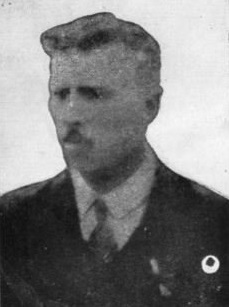
Towards the end of 1920 nine members of the Millstreet battalion whose names were on the ‘murder list’ of the Tans, formed a flying squad or small flying column. The late Jeremiah Crowley was in charge of this body of men and under his direction training in military operations was carried out. The squad was reinforced considerably later on, and an effective column of close on forty men was formed. On the night of 3 January 1921, the squad, which then consisted of nine men all told arrived in Rathmore. The late Con Murphy, having arranged billets, went home to his father’s house in Ballydaly – a quarter of a mile from the nearest house where the squad was in billets. At about nine o’clock on the morning of 4 January, the scouts protecting the squad reported the presence of a considerable force of military and Royal Irish Constabulary raiding in Ballydaly. The little squad immediately got into a position of defence. Retreat was out of the question as the only way out was occupied by the enemy. There was another line of escape if circumstances were favourable, by crossing the River Blackwater. On this day it was flooded, so the only alternative in case of attack was to fight to a finish., With this end in view positions were taken up in the old rath. There was not, however, and raid of attack at Rathduane. After a few hours scouts brought the information that the raiders had departed in the Millstreet direction, taking Con Murphy, his father, Denis Murphy, and his two brothers, Tim and Denis, with them as prisoners. Con was later tried by court martial and found guilty of having a revolver in his possession. He was executed at Cork Military Barracks, and was the first man in the campaign to suffer the death penalty for carrying arms. – from “Rebel Cork’s Fighting Story, 1916-21: Told by the Men who Made it“
====
Final Resting Place
 Con and twelve more volunteers are buried at the IRA Memorial in UCC in front of the Science Building, formerly the site of the old Cork County Jail where Con Murphy was executed.
Con and twelve more volunteers are buried at the IRA Memorial in UCC in front of the Science Building, formerly the site of the old Cork County Jail where Con Murphy was executed.
 Con is remembered at the family plot in Drishane Cemetery [Find a Grave]
Con is remembered at the family plot in Drishane Cemetery [Find a Grave]
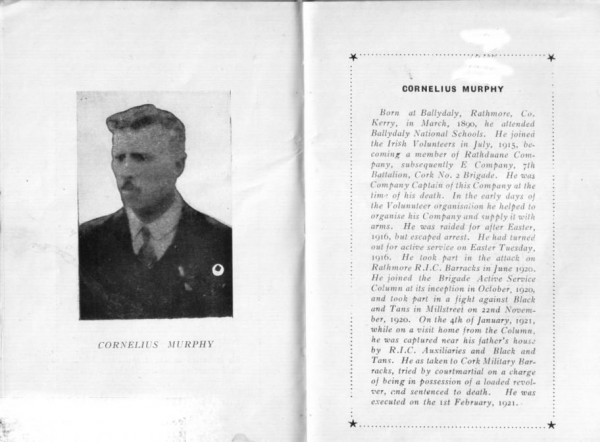
====
Trial
The trial in the Military Court, Cork, was held on January 17th, for the crime of improper possession of arms and ammunition on January 4th 1921 in Ballydaly.
TODO: details of the trial anywhere?
====
Inquest on his Death
3/Feb/21 Court of Inquiry in lieu of Inquests – Civilian Cornelius Murphy
PROCEEDINGS of a Court of Inquiry assembled at Victoria Barracks on the 1st February 1921 by order of Maj. Gen. Sn EP Strickland KCB CMG DSO Commanding VIth Division for the purpose of enquiring into and the circumstances attendant on the death of Cornelius Murphy, civilian of Ballydaly, Rathmore, Co. Kerry.
PRESIDENT: Major CD Kirkpatrick MCRGG
MEMBERS: Captain P Nerill(?) RGA, Captain CA Branston Essex Fort ren RETF
IN ATTENDANCE
The court having assembled pursuant to order, proceed view the body, and then take evidence
===
1st Witness: Major Peter Trant Foley, assistant provost marshal 6th Division sworn states: I am APM to the 6th Division, Cork. On January 30th 1921 Cornelius Murphy of Ballydaly, Rathmore, in the county of Kerry, farmer, single aged thirty one years, was handed over to me as APM.
On that day I promulgated to the said Cornelius Murphy, the duly confirmed proceedings of a military court, held at Victoria Barracks in the city of Cork, on the 17th day of January 1921 hereby the said Cornelius Murphy was sentenced to death by being shot for having committed offences against martial law, namely being in improper possession of arms and ammunition at Ballydaly aforesaid on the 4th January 1921.
I informed him he would be executed at 800 hours on the 1st of February 1921. I produce such proceedings to the court with minutes of confirmation and promulgation duly endorsed. I was present as APM at 0801, Feb 1st 1921, at the Military Detention Barracks, Cork aforesaid when and where the said sentence was duly executed upon the said Cornelius Murphy, whom I identified as being the same Cornelius Murphy to whom I had promulgated the said proceedings as aforesaid. The said sentence was carried out in a proper and expeditious manner. The deceased was a R.C. and was attended by a priest to the last.
2nd Witness: Captain Allan Wie Clarke, RAMC sworn states:- I was present at the military Detention Barracks, Cork at 0801 hours February 1st 1921, when Cornelius Murphy suffered death by being shot. I examined his body immediately after the firing party had discharged their duty and found life extinct. Death was instantaneous and was caused by shock and haemorrhage, due to rifle fire. A.W. Clarke, Captain RAMC
Opinion: The Court having carefully considered the evidence find that
1. The accused Cornelius Murphy resided at Ballydaly, Rathmore, in the County of Kerry, was a man, unmarried and thirty one years of age.
2. That the said deceased died at the Military Detention Barracks, Cork on February 1st 1921 at 0801 hours, having been confined there on a charge of having committed offences against martial law
3. That death was due to shock and haemorrhage due to rifle fire.
4. That the said deceased suffered death by shooting in accordance with a sentence passed upon him by a Military Court, held at Victoria Barracks Cork, on January 17th 1921
5. That the said sentence was duly confirmed and promulgated
6. That the sentence was carried out in a proper and expeditious manner
Signed at Victoria Barracks, Cork this first day of February 1912
====
From the Freeman’s Journal
Reaction in Westminister:
====
Earlier life
Con Murphy was born in Rathduane, Ballydaly on March 7th 1890, the second youngest of six children (Helena, John, Tim, Denis, Con, Dan) to Denis Murphy (farmer) and Kate Creedon[birth]. He is seen at home for the 1901 and 1911 census. He joined the volunteers in 1915, becoming a member of the Rathduane Company, subsequently E Company 7th Battalion Cork No.2 Brigade.
In the early days of the volunteer organisation, Captain Murphy helped to organise the company and supply arms and he narrowly escaped capture after Easter Sunday. He turned out for active service on Easter Tuesday and took part in the attack on Rathmore RIC Barracks in June 1920.
Con Murphy joined the active service column, later to become the flying column, at its inception in 1920 and took part in the fight against the Black and Tans in Millstreet on November 22 1920. [ref]
====
Monument in Ballydaly
CAPTAIN Con Murphy of Ballydaly was the first person to be executed, on February 1 1921, under a new British law imposing the death sentence for possession of arms and, on the 80th anniversary of his death, his relatives and members of the wider community will erect a memorial monument in Ballydaly this Easter Sunday.
RTE historian Pat Butler will be in attendance on the day and will give a special oration at the monument, after 12 noon mass at the Church of Our Lady of Lourdes and a parade led by Millstreet Pipe Band to the monument site.
Con Murphy was born in Ballydaly in March 1890, and joined the volunteers in 1915, becoming a member of the Rathduane Company, subsequently E Company 7th Battalion Cork No.2 Brigade.
In the early days of the volunteer organisation, Captain Murphy helped to organise the company and supply arms and he narrowly escaped capture after Easter Sunday. He turned out for active service on Easter Tuesday and took part in the attack on Rathmore RIC Barracks in June 1920.
Con Murphy joined the active service column, later to become the flying column, at its inception in 1920 and took part in the fight against the Black and Tans in Millstreet on November 22 1920.
On January 4 1921, while on a visit home from the column, Con Murphy was captured near his father’s house by RIC auxiliaries and Black and Tans. He was taken to Cork Military Barracks, tried on a court marshall on a charge of being in possession of a loaded revolver and sentenced to death.
The law under which he was charged had just come in to effect in December 1920 and he was the first to be executed under this law. His remains lie in Cork jail yard, which is now owned by UCC.
A specially commissioned sculpture is being prepared to mark the 80th anniversary and it will be erected on the main road in Ballydaly. Captain Con Murphy Memorial Committee secretary John O’Brien said. The cost of this project is estimated at £3,500 to £4,000 and the committee would be grateful for any contributions to the fund. These can be forwarded to joint treasurers Timothy D Murphy, Ballydaly, Rathmore, Co Kerry or Kathleen Cronin, Caherbarna, Rathmore, Co Kerry.
Below are some photos from the unveiling of the Monument in Ballydaly [Seán Radley]
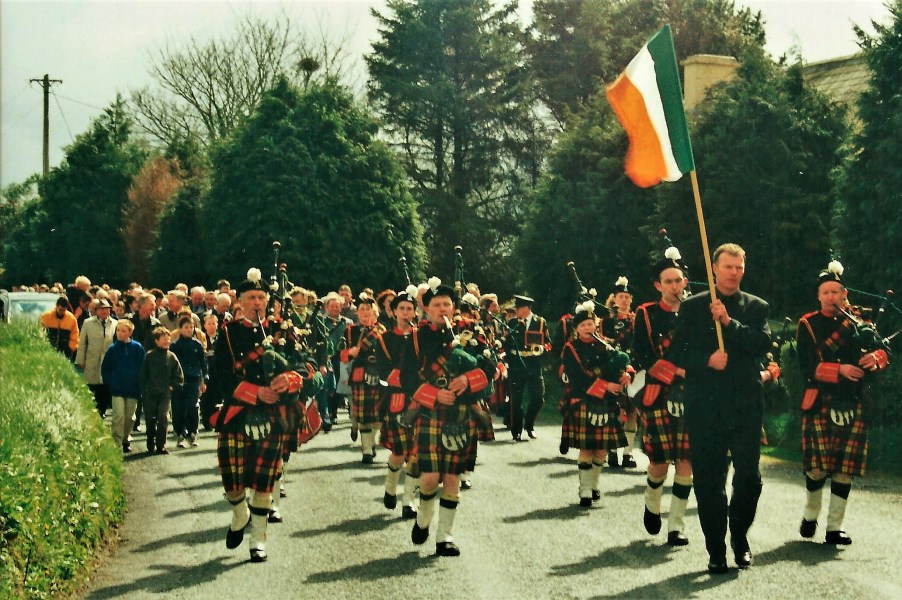
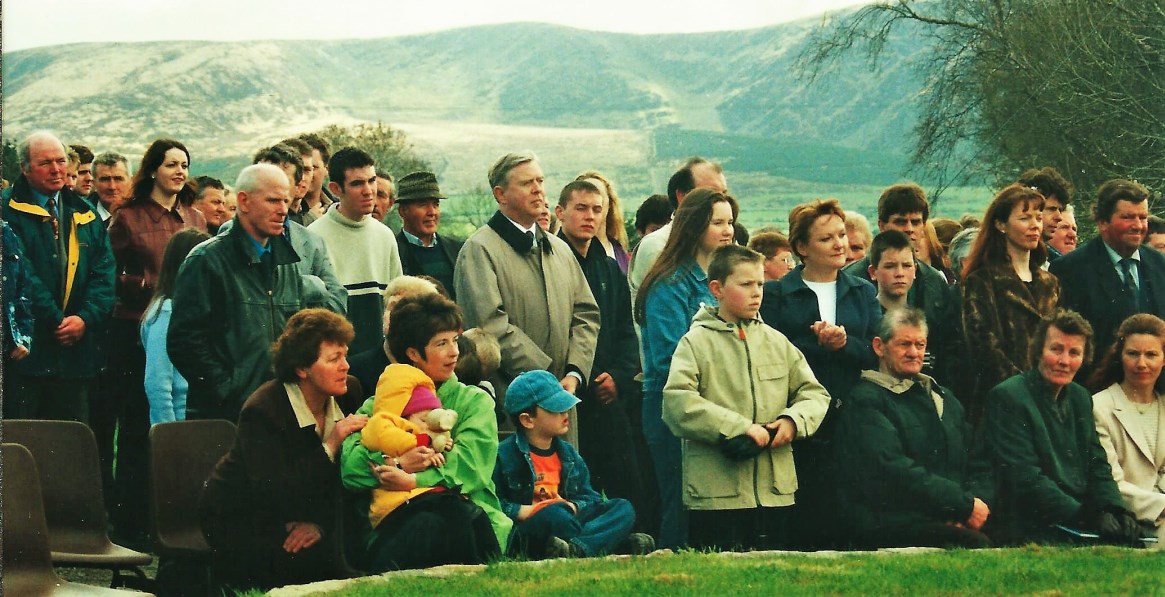
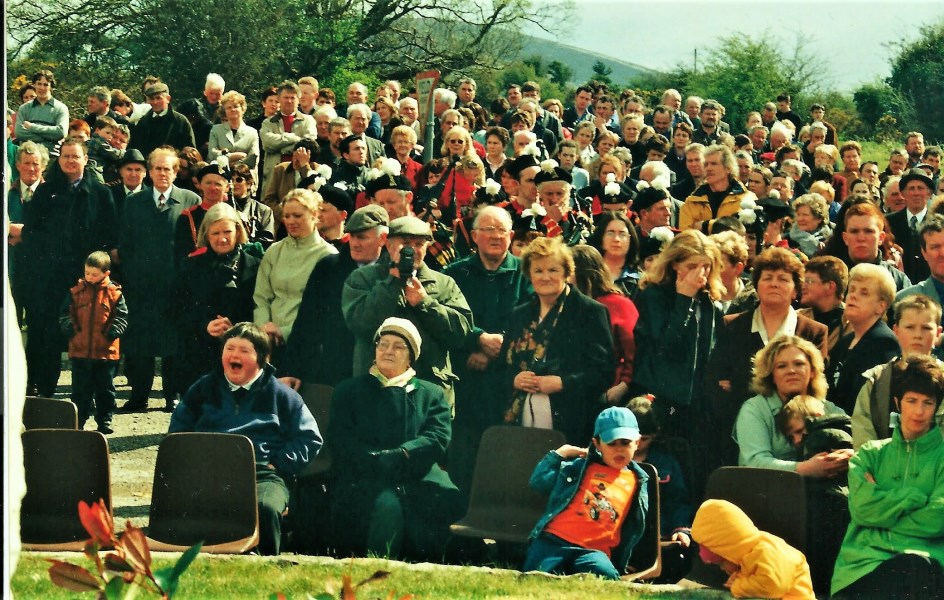
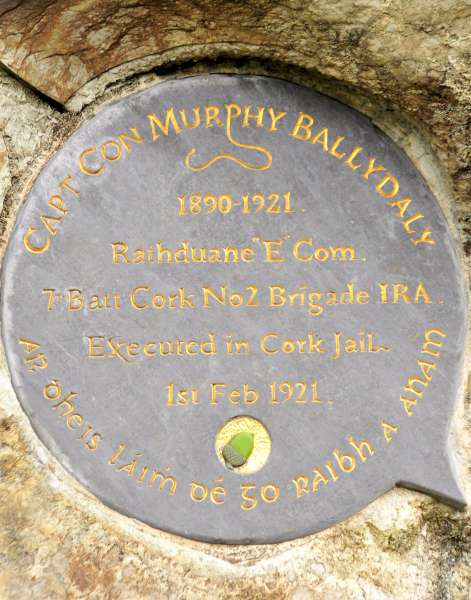 The plaque on the memorial to Captain Con Murphy in Ballydaly [1]
The plaque on the memorial to Captain Con Murphy in Ballydaly [1]
===========
Murphy had previously taken part in the IRA ambush at Kilmichael in November 1920 [ref]
===========
There’s a much more detailed essay on Con and his activities from 1915 until 1921 written by his Grand Niece Orla Murphy . It can be found on pages 44 to 46 in a Millstreet Miscellany 3 (download it from the Aubane Historical Society website).
Captain Cornelius Murphy: 1915-1921
First Volunteer of the Irish Republican Army to be executed under Martial Law for possession of firearms.
(This a Special Study project for this year’s Leaving Certificate)
In 1921 my great-granduncle, Captain Cornelius Murphy was the first to be executed by the British Firing Squad since the executions of the 1916 Easter Rising Leaders. He was also the first volunteer of the Irish Republican Army to be executed under Martial Law for possession of firearms.
His military career began in December 1915, when Con was appointed Officer Commanding of the Rathduane Company in Ballydaly which comprised of forty men. At the time this was under Tomas MacCurtain’s Cork Brigade of Irish Volunteers, in January 1919, this Company became part of Liam Lynch’s No. 2 Brigade. After the Easter Rising, 1916, the controversy surrounding the executions of the Rising Leaders had grown in intensity, and the Royal Irish Constabulary, (backed by the British Army) raided Ireland for signs of potential threat to English security. Con and his brother Denis were arrested in the aftermath of the Rising as part of a nationwide crackdown on prominent Republicans (more than one hundred men were captured in total). The Murphys arrived at Knutsford, Chesire on June 7th 1916. All the detainees were released in August of that year as the jail was shut down.
From 1918 onwards, Con’s role was in collecting taxes, organising Sinn Fein Courts as well as boycotts of the RIC and English goods- as Jonathan Swift coined in the 1720’s “Burn everything British except their coal.” In 1920, Con was elected as a member of the Millstreet Urban District Council. These responsibilities show what a valued member of the rural community Con was- and the British realised this. Capt. Con was put on the British “Murder List” and had a £300 price on his head (the equivalent of a year’s pay for an Auxiliary Officer or two years’ pay for a Black and Tan soldier). While conducting intelligence work in 1920 he was arrested along with his scout and detained in the local Barracks but escaped after he prised open a window shutter. Unfortunately, his next run-in with the British soldiers proved fatal.
On January 3rd, 1921 the squad moved into the Rathduane area; after arranging billets for his troops, Con returned home. The following morning Con, his brother, and father (both named Denis) were clipping a horse in the farm yard when the Auxiliaries raided the Murphy home. They fled the yard however the officers retrieved Con’s discarded coat from a nearby field which contained a loaded revolver and two spare rounds. The three were arrested and endured three days of interrogation and torture while detained in Ballincollig Military Barracks. Con was tried on January 7th, before a Field Court Martial at Cork Barracks. He was charged with having a revolver in his possession and having seven rounds of ammunition -this broke The Martial Law which had been introduced on December 12th 1920. Meda Ryan explains the significance of the law to Irish citizens, “The Martial Law gave a freedom to the military to do as they wished; they could arrest somebody and didn’t have to justify themselves or give the accused a fair trial ” His charge and consequent execution set precedent for further executions of Republicans with the same charge. The novelty of the law as well as its injustice sent the Republican community into a state of shock; this was a time of reprisals, where houses were being burned and those who opposed the Black and Tans suffered severely. Con stated first that he found the firearm but later contradicted himself in court saying the revolver did not belong to him but that he was holding the gun overnight for a man whom he did not recognise, and did not mean any harm by having it in his possession, (this was general practice at the time).
He stated the man asked him for his name and address, and asked him to hold the firearm and ammunition until the following night. Con was not willing to do so but accepted. He said he did not know about the Martial Law or he would not have taken them from the man; there were no public notices posted up within four of five miles of his home place. However, the prosecutor later mentioned that the proclamation had received all the necessary publicity in the various districts. Con then told the court that none of his family knew about the incident. Nevertheless, his brother, Denis Murphy was charged on two counts; firstly for not informing the RIC that his brother had a revolver in his possession and secondly for failing to inform the Competent Military Authority that his brother was in possession of revolver ammunition not under effective military control.Con was then detained in Cork Military Barracks and was briefly transferred to Cork Gaol, before being brought back to Cork Military Barracks for his execution by Firing Squad on February 1st 1921. Denis, who was still detained, was called at dawn to speak to his brother. Con’s parting sentiments were, “Tell the boys they have nothing to worry about. There is no need to move anything. They [the authorities] have been told nothing… It is as well to die now as it is at any other time… Give my love to all” [Denis Murphy’s prison diary.]
Capt. Con’s charge and consequent execution set precedent for further executions of Republicans with the same charge. The novelty of the law as well as its injustice sent the Republican community into a state of shock; this was a time of reprisals, where houses were being burned and those who opposed the Black and Tans suffered severely. Although the harsh sentence bestowed upon Captain Murphy was a symbol of intolerance on the part of the RIC- Proclamation No. 1 states, “..her [Great Britain’s] sole object in declaring MARTIAL LAW is to restore peace to a distracted and unhappy country; her sole enemies are those who have countenanced, inspired and participated in REBELLION, MURDER and OUTRAGE. It is to put an end, once and for all, to this campaign of CRIME that MARTIAL LAW has been declared.”
His execution was considered differently by some in Westminster; British Cabinet member and former Attorney General, Lord Birkenhead led the public outcry which questioned the abandonment of basic legal rights in Ireland. Lord Birkenhead’s impartial stand at the injustice of the execution shows how the British began to reconsider their position on their policing in Ireland. “…The most essential duty, because the ability to enjoy the other rights…can only be guarded by the ability to defend citizenship…Ireland armed will make a better bargain with the Empire than Ireland unarmed. ” [Padraig Pearse, at the establishment of the Irish Volunteers; regarding the right to bear arms].
I think Pearse’s theory was the reason for the initiation of Martial Law; if the Irish were defenceless they would be easier to govern. It also caused anger in Ireland as Pearse called the right to carry arms, “The proudest right”. This was a step too far for Republicans who were fed up with inequitable laws introduced by an Empire.
Con was as much a hero as the last two soldiers to die before Firing Squad- James Connolly and Sean McDiarmuid, however his name and sacrifice have been celebrated in a smaller community. As Lieutenant General Sir H. Lawson said, “It is no exaggeration to say that, as a class, they represented all that as the best in the countryside.”
Most of all, his dedication, life and the manner of his death were proof that the spirit of the 1916 Rising remained unbroken.
For more on the activities of the time, read the Boys of the Millstreet Battalion Area, which was published by the Aubane Historical Society:
====
Captain Con Murphy’s Terrace
Murphy’s Terrace on the Liscahane Road is called after Captain Con Murphy. It was built in the 1950’s (?). [GMaps: Murphy’s Terrace]
By coincidence, the day of the unveiling of the monument to Con in Ballydaly, was also the day of the funeral of Paddy Cronin of No. 1, Murphy’s Terrace! [1] There’s a plaque on the side of Paddy’s house his which says “Captain Con Murphy’s Terrace” [GMaps]
TODO: get a photo of the plaque on the side of #1 Murphy’s Terrace
==================
 Official Death Certificate [3] [4] [civil register]
Official Death Certificate [3] [4] [civil register]
==================
Failed Pension Application
Con’s parents Denis and Kate applied for a pension in 1923, claiming that he contributed £30 to the household per annum before his death. The application was eventually denied claiming they were living in good circumstances.
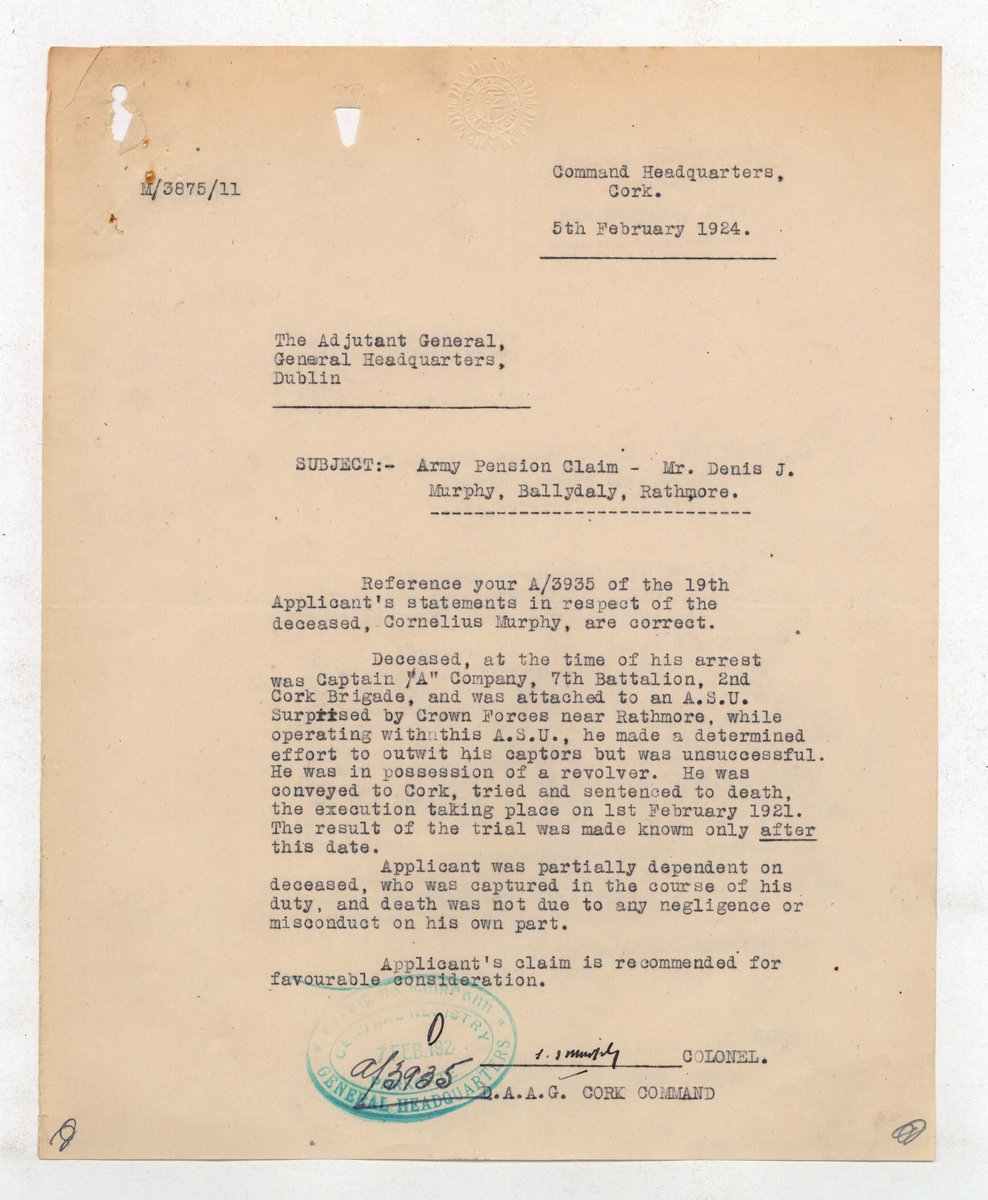 From the pension application files [3]
From the pension application files [3]
Report as to dependency of Applicant or of the motherless children upon Deceased a the time of his death:
The Civic Guard Report states that the Applicant (Denis and Kate Murphy) is a retired farmer aged 73 years and is in very good circumstances.
He has a farm of about 130 acres and was not very much dependant on his son during the latter’s life, but since his death he had to employ a man paying him £30 per annum. Prior to the death of his son he managed the Farm himself and made about £100 per year out of it. He had no other income. He has now handed the farm over to his eldest son who is a married man and allows him£16 per year.
The deceased was an acive member of the I.R.A. participating in many ambushes including Kilmichael.
He was arrested by the RIC and found in possession of a revolver.
He was executed in Cork Gaol.
The Applicant was not very much dependent on his deceased son. ….
I am to request that you will place before the Minister for Defence the recommendation of the Army Pensions Board that in accordance with Section 7, 8 of the Act there shall be NO AWARD granted to Mr. Denis J. Murphy.
???? Gorman – Army Finance Officer [21/March/1924]
Military Service Pensions Collection – Cornelius Murphy Ballydaly – File 1
Military Service Pensions Collection – Cornelius Murphy Ballydaly – File 2
====
Monument in the Square, Millstreet
Con Murphy is one of five listed on the National Monument in the Square in Millstreet [more]
====
Poetry
The Martyr by Francis Duggan
He lived in Ballydaly a noble Irishman
Executed by the British just because he loved Ireland
And though the time has long passed by his story must be told
Like every Irish martyr he was noble true and bold
He was arrested for possessing arms and received an unfair trial
And was scorned by the pretence judge who treated him so vile
The so called soldiers who murdered him in that grimy prison cell
Are surely all with Satan now down in his accursed hell.
He was buried in a dungeon far from his native home
And over this man’s coffin no Irish flag was flown
He died like a true hero under gunfire he did fall
And he gave his life for Ireland with his back against a wall.
There’s little doubt Con Murphy was a truly noble man
He loved his Country Ireland and he hated Black and Tan
And all things of life must die someday and what better way to depart
Than as a martyr for your Country with a bullet in your heart.
Men like him will be remembered until the end of time
The true love of his Country was his sole and only crime
Too many of our better men in troubled times have died,
Too many Irish mothers have broken down and cried.
His memory is well preserved in nearby Millstreet Town
The Terrace a memorial to honour his renown
Con Murphy died a martyr and brought glory to his name
To rid Ireland of British rule his unselfish life aim.
———-
Con Murphy was a man from Ballydaly by Francis Duggan
Con Murphy was a man from Ballydaly he lived about four miles from Millstreet Town
The first Irish person executed for possessing arms by the then Government of the British Crown
By all accounts a brave and decent person his life was cruelly cut short in his prime
But his merciless judges gave to Ireland one more hero whose legend lives on through the years of time
.
I knew old men who remembered Con Murphy they described him as a brave and mighty man
He loved his Country Ireland with a passion and wished to rid it of the Black and Tan
The British Government abused their rule in Ireland one might say in the worst possible way
But at least they gave us heroes like Con Murphy whose legend is alive and well today
.
Murphy’s Terrace in Millstreet Town named in the honour of one quite worthy of enduring fame
The death penalty in any case barbaric in any Nation quite a thing of shame
His murderers robbed him of his right to father children and robbed him of his chance to take a wife
And they robbed him of the greatest gift that he had when they took away from him his gift of life
.
The British Empire now a fading memory Empires rise and fall it has always been this way
But the lessons of war never have been learned as more wars are fought around the World today
And war robs every nation of it’s young and bravest and in wars around the World far too many have died
But young men who die in the manner of Con Murphy are destined to become heroes Nation-wide.
====
Further Reading
The Irish Revolution: Colunteer Captain Con Murphy
For more on the activities of the time, read the Boys of the Millstreet Battalion Area, which was published by the Aubane Historical Society in 2003:
====
#OnThisDay 1921 IRA member Con Murphy (1D87) executed at Victoria (Colins) Barracks, Cork for the illegal possession of a revolver. Murphy had previously taken part in the IRA ambush at Kilmichael in November 1920. #MSPC #archives pic.twitter.com/p4i3b8xMYW
— Military Service Pensions Collection (MSPC) (@mspcblog) February 1, 2018
@inflation11– Con Murphy executed 100 years ago on 1/02/1920 – memorial in Ballydaly. #OnThisDay #History pic.twitter.com/LbB00rCwv4
— Jerome Ring (@inflation11) January 31, 2021
====
Unveiling of the Memorial in UCC in 1948
After the successful fundraising drive and construction, the unveiling of the memorial and the plaque took place on Sunday, July 11, 1948. A procession with five bands left the Grand Parade at 2pm, arriving at UCC by 4pm when Éamon de Valéra TD (he was no longer Taoiseach) unveiled the memorial plaque on the gaol wall. He then entered the UCC grounds, where he was met by university president, Dr Alfred O’Rahilly, and the registrar, Professor Henry St J. Atkins. The monument was blessed by the Rev. Fr Augustine Hayden OFM Cap. Like other Capuchins, Fr Augustine was closely associated with the republican movement, having ministered to Padraic Pearse and James Connolly after the Easter Rising and officiated Terence and Muriel MacSwiney’s wedding in 1917.
After his blessing, a decade of the Rosary was recited. A firing part consisting of IRA veterans then fired three volleys and the Last Post and Reveille were sounded. De Valéra then addressed the crowd from a platform erected nearby.
The unveiling was used to mark the handing over to UCC of the “sacred soil which enshrouds the ashes of these brave men”. Mr O’Rahilly accepted the memorial on behalf of UCC, thanked the Cork Gaol Memorial Committee which had presented it, and the outgoing government for its generosity in handing over the site. Mr O’Rahilly reminded the audience that he himself had been imprisoned in 1921, and recalled hearing the gunfire of some of the executions. A photograph of the grave monument being unveiled on the day was printed in the Cork Examiner; this shows the gaol in the background.
In 1992, three stones were laid on the grass with the names, in English, of those buried in this plot, with place of origin, along with a text: “Here lie the mortal remains of 13 Volunteers of the Irish Republican Army executed by British firing squads in the Cork Military Barracks in 1921 and buried here in what was then a part of the exercise yard of the former Cork County Jail.” The centre stone has a quotation from Padraic Pearse (this is also on the memorial plaque on the gaol wall): “Beidh iomrádh ortha i measc a muinntire cuimhneochaidh an uile ghlún iad agus mórfaid said a n-ainm Pádraig Mac Piarais”. The names of the 13 buried here were inscribed again on the flat stones of the surrounding kerb. [1]
====
Loose Ends
TODO: get a photo of the plaque on the side of #1 Murphy’s Terrace
TODO: are the details of the trial anywhere?

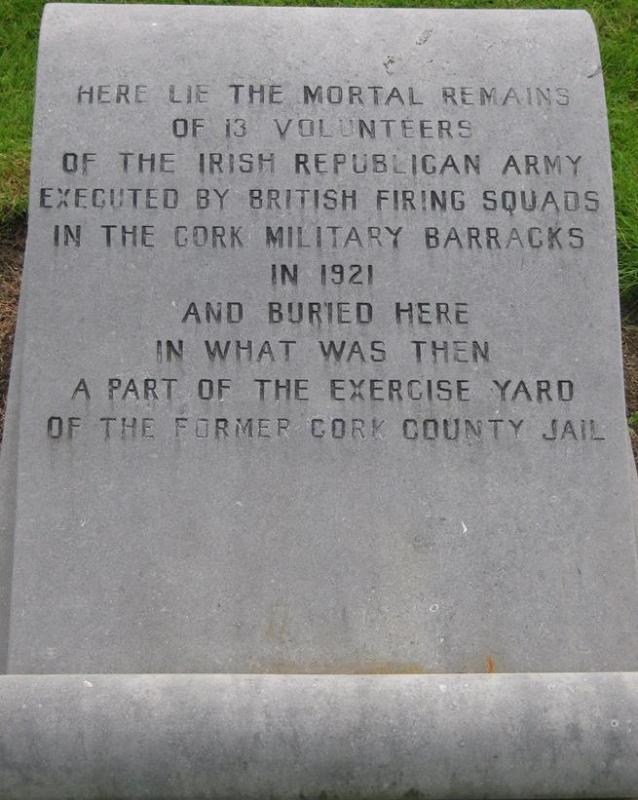


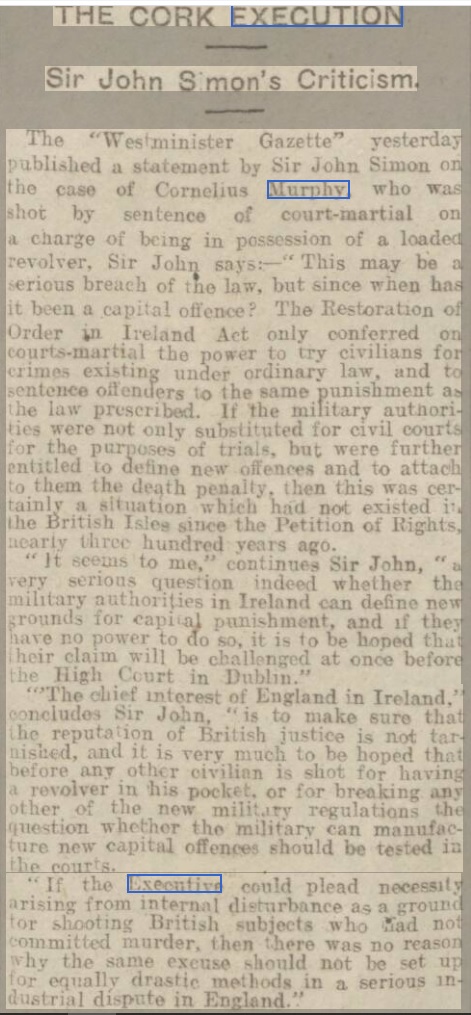
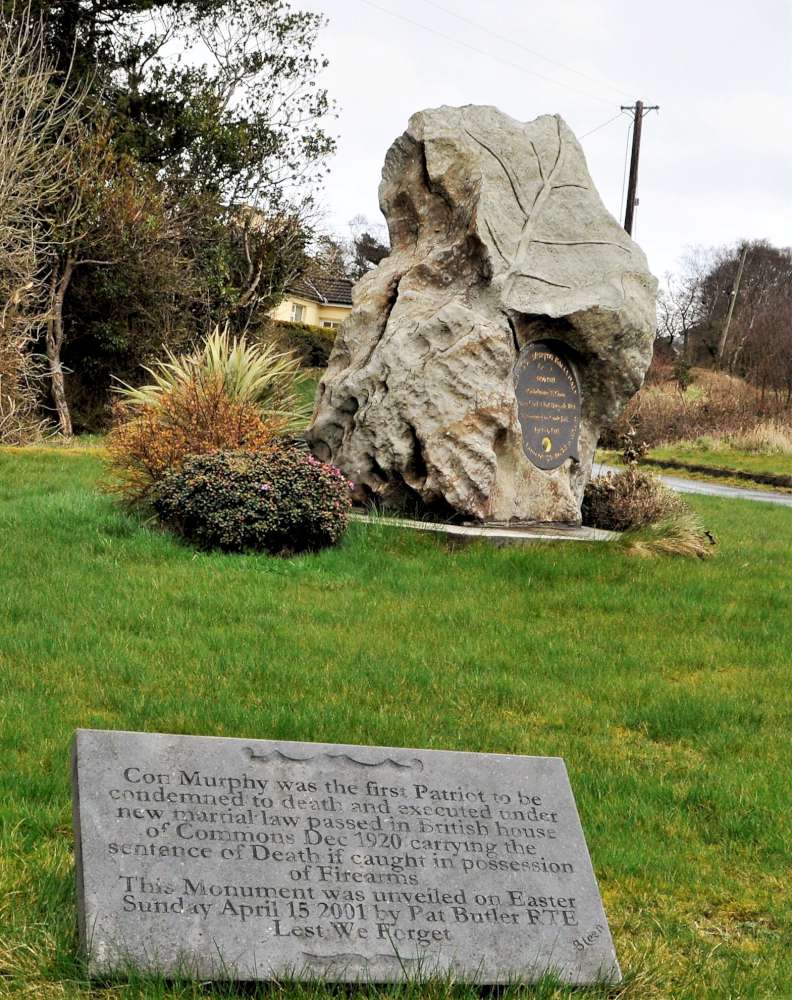


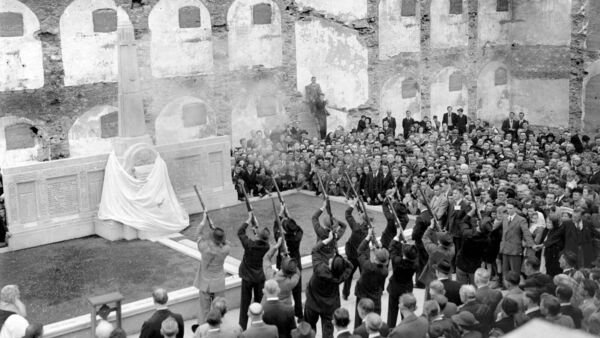
So well told RIP Con Murphy